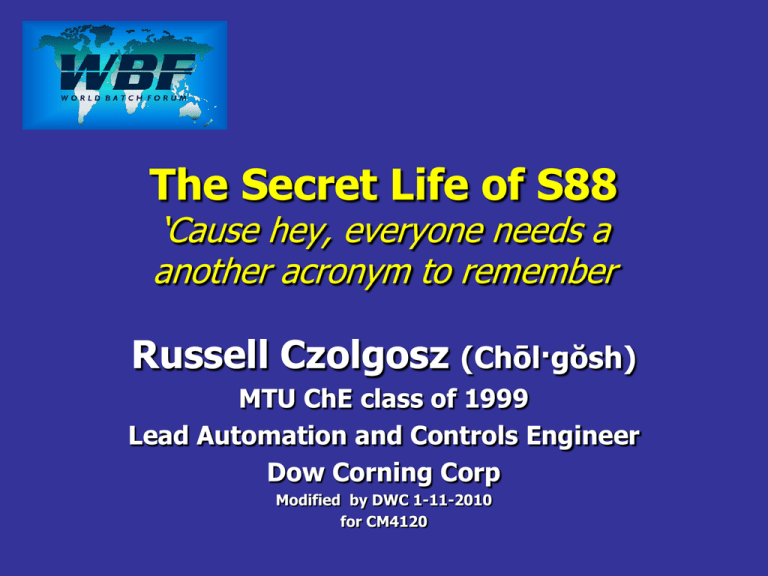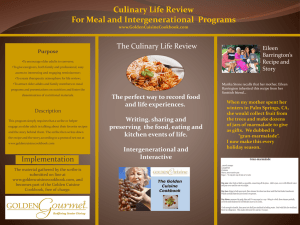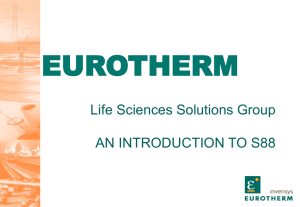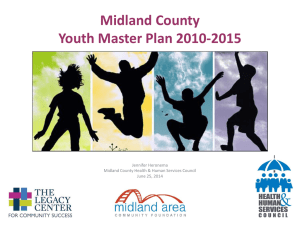Intro to S88
advertisement

The Secret Life of S88 ‘Cause hey, everyone needs a another acronym to remember Russell Czolgosz (Chōl·gŏsh) MTU ChE class of 1999 Lead Automation and Controls Engineer Dow Corning Corp Modified by DWC 1-11-2010 for CM4120 Outline Background What is ISA and S88? Recipe Types 4-parts of the S88 Model Physical Model Process Model Procedural Control Model Control Activity Model Tying it all together The Secret Life of S88 New Employee Training, Midland MI June 11, 2009 2 Typical Manufacturing Challenges Need Predictable Product Quality Variation in feedstocks Poor control of manufacturing processes Human error Differences between processing locations Overcome High Manufacturing Costs Low equipment utilization – difficulty in scheduling Using old processing/control technologies Labor intensive High cost of energy Poor flow of material and information Would Like New Markets/ New Products Need “Agility” but have a dedicated system Rigid design creates long product/process development times The Secret Life of S88 New Employee Training, Midland MI June 11, 2009 3 Traditional Process Development 1. Design equipment for a specific process/ product 2. Develop procedures to make that product 3. Implement process control to meet the product requirements and fit the SOP 4. At completion all aspects of the SOP/ product/ equipment/ control are rigid, hardcoded, and fixed This type of implementation: Hinders Process Improvement Prohibits Manufacturing Agility Prevents Asset Optimization The goal of S88 is to prevent these roadblocks. The Secret Life of S88 New Employee Training, Midland MI June 11, 2009 4 ISA S88 is... ISA – International Society of Automation S88 (or ISA 88) Batch Control Standard Currently a 4-part standard Part 1 Models and Terminology (ANSI/ISA-88.01) Part 2 Data Structures & Guidelines for Languages (ANSI/ISA-88.00.02) Part 3 General and Site Recipe Models & Representation (ANSI/ISA-88.00.03) Part 4 Batch Production Records (ANSI/ISA-88.00.04) Part 5 is currently in draft SP88 is the Batch Control Standards The Secret Life of S88 New Employee Training, Midland MI Committee June 11, 2009 5 The Intent of S88: Promotes modularity and flexibility Emphasizes good practices for design/ operation Provides a common concepts, framework, models, and terminology Improve efficiency/ control of mfg. plants (batch, semi-continuous, and continuous) It is a guideline, NOT a compliance standard The Secret Life of S88 New Employee Training, Midland MI June 11, 2009 6 S88 – Must be Interpreted! S88 defines general practices Written to apply to the entire processing industry Makes suggestions and provides examples Does not list requirements Suggests standardized modular design concepts Reusable design components Similar to object-oriented computer programming The Secret Life of S88 New Employee Training, Midland MI June 11, 2009 7 Benefits of an S88 Solution? 1. Modularity allows for easier replication and 2. 3. 4. 5. better ROI Design concepts make validation easier S88-aware solutions help track product and process data Gathering requirements from customers/ conveying requirements to vendors is easier Provides guidelines on how to recover from abnormal events The Secret Life of S88 New Employee Training, Midland MI June 11, 2009 8 Spirit of S88 Not just a standard for software, equipment, or procedures A new way of thinking – a design philosophy Understanding S88 will help you design better processes and manufacture better products Isolates equipment from recipes The Secret Life of S88 New Employee Training, Midland MI June 11, 2009 9 Improved Batch Processing Throughput Cost Reduced batch cycle time Increased production rate Faster changeover More scheduled recipes Reduced downtime Faster process development Quicker product launches The Secret Life of S88 Reduced raw material loss Improved batch consistency Better equipment utilization Less time to add/modify recipes Lower engineering cost Lower data capture cost Better data availability New Employee Training, Midland MI June 11, 2009 10 Steps in Applying S88 1. Learn the terminology 2. Break the process down into appropriate 3. 4. 5. 6. components Identify the steps necessary to produce the product Identify recipe parameters Tie the recipe to the procedures Map the procedure to the processing equipment The Secret Life of S88 New Employee Training, Midland MI June 11, 2009 11 S88 Recipe Types What we want to make, what equipment we need, and how we want to do it The Secret Life of S88 New Employee Training, Midland MI June 11, 2009 12 4 Recipe Types General Recipe May be transformed into Site Recipe May be transformed into Master Recipe May be transformed into Control Recipe Ref. S88.01 Fig.8 – Recipe types The Secret Life of S88 1. General Recipe Enterprise-wide Includes product-specific processing information 2. Site Recipe Specific to a site Includes site-specific information (language, raw materials, on-site limitations, etc.) 3. Master Recipe Targeted to a specific cell Starting w/ a Site Recipe, is adapted to Process Cell-specific equipment 4. Control Recipe Consists of a Master Recipe plus Batch ID, batch size, etc. Forever tied to a particular batch and is specific to that batch – permits product tracking New Employee Training, Midland MI June 11, 2009 13 Recipe Definition A recipe holds the data that uniquely identifies the components of a specific product Ingredients to use Quantity of ingredients Equipment requirements The order in which tasks are performed Recipes do not contain scheduling or equipment control information The Secret Life of S88 New Employee Training, Midland MI June 11, 2009 14 Applying S88 – 4 Models Defined 1. Process Model 2. Physical Model 3. Procedural Control Model 4. Control Activity Model The Secret Life of S88 New Employee Training, Midland MI June 11, 2009 15 S88 The Process Model Describes the hierarchical ordering of process functionality needed to produce a batch. Is not equipment specific – very conceptual. Used to develop the recipe procedures section in the General and Site Recipes (high-level recipes). The Secret Life of S88 New Employee Training, Midland MI June 11, 2009 16 Process Model General and Site Recipe procedures will be based on the “Process Model” Process Make PDMS Consists of an ordered set of Process Stage Polymerize Remove Low Boilers Cool Product Consists of an ordered set of Process Operation Prepare Reactor Charge React Consists of an ordered set of Process Action The Secret Life of S88 Add req’d 245 Fluid Add req’d Endblocker Heat to 140 C New Employee Training, Midland MI June 11, 2009 17 S88 The Physical Model The equipment used to perform the process. Defines the hierarchy of the equipment. The Secret Life of S88 New Employee Training, Midland MI June 11, 2009 18 Physical Model Subdivision of the corporation’s PHYSICAL ASSETS organized in a hierarchy of equipment that consists of several integrated levels MTU Houghton Enterprise Process Cell Site Unit Chem Sci Building Area Equipment Module PSCC Consists of all the production and supporting equip necessary to make a batch A major piece of equipment within a process PDMS Reactor cell that performs a Unit specific task Solvent Recovery Unit Agitator Temp Feed Discharge Grouping of equipment & control modules that together perform a minor task Basic discrete and analog Control Module The Secret Life of S88 Agitator control (output) devices Controls Outlet valve Temp Controller New Employee Training, Midland MI June 11, 2009 19 An Example Process Cell Process Cell Material Selection Material Charging FT Mix Pressure Control M Unit Temperature Control TT PT Discharge and Recirc Equipment Module Pump FT Control Module The Secret Life of S88 New Employee Training, Midland MI June 11, 2009 20 Process Cell Defining a Unit Unit Equipment Module Control Module Batching cannot occur without units Batching occurs in units Units perform one or more major processing activities A unit is used on only one batch at a time A Unit runs a recipe Combine ingredients, or perform a reaction Adds value to your product or intermediate Units function independently of each other The Secret Life of S88 New Employee Training, Midland MI June 11, 2009 21 Examples of Units: Is a Unit Mix-making batch tank Pasteurizer Reactor Pump Ingredient storage tank Washing machine Kitchen blender Refrigerator Dishwasher The Secret Life of S88 Is Not a Unit 4 4 4 4 4 4 4 4 4 New Employee Training, Midland MI June 11, 2009 22 Process Cell Equipment Modules Unit Equipment Module Equipment modules group devices for performing one or Control Module more specific minor processing activities Equipment modules run portion(s) of a recipe FT Material Charging Equipment Module The Secret Life of S88 Mix M New Employee Training, Midland MI June 11, 2009 23 Process Cell Control Modules Unit Equipment Module Control Module “connect” software to the process through sensors and actuators Control modules Act as a single entity from a control standpoint Carry out Basic Control – they control do not contain procedural Material Selection Temperature TT Control The Secret Life of S88 New Employee Training, Midland MI June 11, 2009 24 Physical Model is Collapsible Process Cell Unit Equipment Module Although a process cell must contain at least one unit: A control module does not have to be part of an equipment module to be part of a unit A unit can “own” control modules directly Control Module The Secret Life of S88 New Employee Training, Midland MI June 11, 2009 25 S88 The Procedural Control Model Sequence of steps necessary to produce a batch. Defines the sequential control that enables equipment to perform the process task. Used to develop the Recipe Procedures section of the Master Recipe The specific control setpoints, quantities, controller modes, etc. required to make a defined quantity of a certain product The Secret Life of S88 New Employee Training, Midland MI June 11, 2009 26 Procedural Control Model Defines the process strategy for making a batch within a process cell -A hierarchy of the actions that are performed to complete a batch Defines the actions that are performed on a Unit -Consists of an ordered set of Operations that control the functions of the unit Defines an ordered set of phases that are arranged to perform a particular function within a unit -One or more operations could occur simultaneously Defines a simple action or command to set or change the state of an Equipment Module -Can be subdivided into steps and transitions The Secret Life of S88 Procedure Unit Procedure Operation Phase New Employee Training, Midland MI Make PDMS Polymerize Remove Low Boilers Cool Product Prepare Reactor Add Ingredients Heat Add 245 Add Endblocker June 11, 2009 27 Procedural Control Model Example Procedure Make Toothpaste Unit Procedures Make Paste Make Gel Swirl Operations Prepare Tank Add Ingredients React Add Water Add Fillers Phases The Secret Life of S88 Phases are the workhorses. Other levels simply group, organize, and direct phases. New Employee Training, Midland MI Add NaF June 11, 2009 28 The Automation Specification: Physical Model Enterprise A document that describes how Equipment Modules are related to a Unit and how the Phase(s) control each Equipment Module Site Procedural Control Model Procedure Area Process Cell Unit Procedure Unit Operation Equipment Module Control Module The Secret Life of S88 New Employee Training, Midland MI Phase June 11, 2009 29 S88 Models Tie Together thru Mapping Relates the procedural control model to the physical model to provide the processing described in the process model Involves MAPPING of Procedural Elements into Physical Entities The Secret Life of S88 New Employee Training, Midland MI June 11, 2009 30 S88 – Model Relationships Procedural Control Model Procedure Unit Procedure Physical Model Combined With a + Process Cell Unit(s) + Operation(s) Unit(s) + Phase(s) Phase(s) Process Model Provides process functionality to carry out a… Process Provides the functionality to carry out a… Process Stage = = Unit(s) + Equipment Module(s) = Process Operation Process Action Process Action Ref. S88.01 Fig.7 – Procedural control/equipment mapping to achieve process functionality The Secret Life of S88 New Employee Training, Midland MI June 11, 2009 31 Separate Models Add Flexibility Separation of Recipe, Procedures, Equipment/ Basic Control into separate models: Each component is maintained as an entity Changes in the Recipe do not necessarily require changes to the Phase Logic Changes to the Phase Logic do not necessarily require changes to the Recipe Changes to physical equipment do not necessarily require changes to the other models The Secret Life of S88 New Employee Training, Midland MI June 11, 2009 32 Summarizing the 1st Three Models Corporate sends a General Recipe to my Site Convert General Recipe to a Site Recipe then Convert Site Recipe to a Master Recipe, for each suitable cell, complete with setpoints, timing, quantities, tolerances, etc. When we make a Batch, the Master Recipe gets transformed into a Control Recipe allocate specific equipment create a batch identifier make the product, record all processing parameters Control Recipe forever tied to that batch of product The Secret Life of S88 New Employee Training, Midland MI June 11, 2009 33 Summarizing the 1st Three Models In our plant, we define: Physical Model (what Units and Equipment Modules we have and the Basic Control that operates each) Procedural Control Model (all the Phases that each Equipment Module can be in, what each Phase accomplishes, and the sequence of operations) Mapping the Physical Model onto the Procedural Control Model produces the functionality described in the Process Model Process Model describes what Process Actions will occur in each Phase of the process The Secret Life of S88 New Employee Training, Midland MI June 11, 2009 34 Recipe Header Original Nestlé Toll House Chocolate Chip Cookies Makes about 5 dozen cookies Batch Size Batch of Cookies! Control Recipe Ingredients: 2 1/4 cups all-purpose flour 1 teaspoon baking soda Master Recipe 1 teaspoon salt 1 cup (2 sticks) butter, softened Formula 3/4 cup granulated sugar 3/4 cup packed brown sugar Inputs 1 teaspoon vanilla extract 2 large eggs 2 cups (12-ounce package) NESTLÉ® TOLL HOUSE® Semi-Sweet Chocolate Morsels 1 cup chopped nuts O p e r a t i o n s Directions: Procedure PREHEAT oven to 375° F. Recipe Parameters COMBINE flour, baking soda and salt in small bowl. Phases Beat butter, granulated sugar, brown sugar and vanilla extract in large mixer bowl until creamy. Add eggs one at a time, beating well after each addition. Transition Expression Gradually beat in flour mixture. Stir in morsels and nuts. Drop by rounded tablespoon onto ungreased baking sheets. BAKE for 9 to 11 minutes or until golden brown. Cool on baking sheets for 2 minutes; remove to wire racks to cool completely. The Secret Life of S88 New Employee Training, Midland MI June 11, 2009 35 S88 The Control Activity Model The 4th Model “Cactus Model” Shows relationships between control activities Describes flow of information throughout the enterprise The Secret Life of S88 New Employee Training, Midland MI June 11, 2009 36 Control Activity Model Master Recipe Recipe Management Master Recipe Batch Production Schedule Planning and Scheduling Batch Schedule Master Recipe Production Information Management Batch Progress Process Batch and Process Management Cell Information Unit Recipes and Commands Batch Status Unit Supervision Commands Batch and Unit Information Statuses Process Data Process Control Commands Statuses Below this line is outside S88 Scope Personnel and Environmental Protection The Secret Life of S88 New Employee Training, Midland MI June 11, 2009 37 Overall Value of S88 Permits easy product customization Color, level of impurities, packaging, viscosity, composition, etc. Facilitates rapid product change-over Helps identify suitable assets at different sites Allows for easy recipe conversion into local languages Remember: S88 is only one element in a system of manufacturing The Secret Life of S88 New Employee Training, Midland MI June 11, 2009 38 References Applying S88 Batch Control from a User’s Perspective, Jim Parshall and Larry Lamb, ISA, Research Triangle Park, NC, 2000. ISA S88.01-1995 (R2006) Batch Control Part 1: Models and Terminology, ISA, Research Triangle Park, NC, 2006. World Batch Foundation, www.wbf.org International Society of Automation, www.isa.org The Secret Life of S88 New Employee Training, Midland MI June 11, 2009 39





